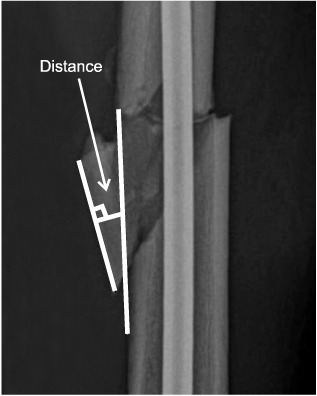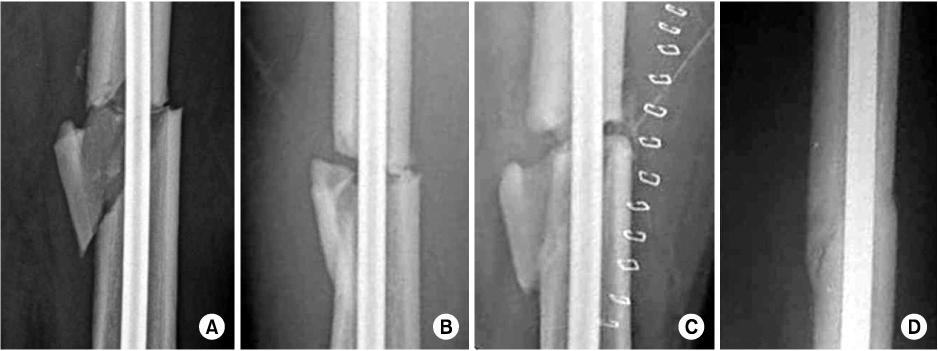J Korean Fract Soc.
2012 Jan;25(1):46-51. 10.12671/jkfs.2012.25.1.46.
The Fate of Butterfly Fragments in Extremity Shaft Comminuted Fractures Treated with Closed Interlocking Intramedullary Nailing
- Affiliations
-
- 1Department of Orthopedic, Busan Paik Hospital, Inje University College of Medicine, Busan, Korea. fracture78@yahoo.co.kr
- KMID: 1434110
- DOI: http://doi.org/10.12671/jkfs.2012.25.1.46
Abstract
- PURPOSE
For conservative treatment of shaft fractures, the butterfly fragments that were somewhat larger in the closed intra-medullary (IM) nailing. The results of treatment were monitored using radiography separately for the weight-bearing femur and non-weight-bearing humerus.
MATERIALS AND METHODS
27 from Group I and 31 from Group II. In the two groups, the displacement and angulation changes in the fragments, and the degree of improvement of these two factors, were compared using follow-up radiography.
RESULTS
The mean angulation of fragments in Groups I and II were 9.2degrees and 9.6degrees, and the mean degree of displacement of the fragments in Groups I and II were 16.7 mm and 21.2 mm, respectively. Follow-up radiography showed that the above factors improved in both groups. The degree of displacement was significantly lower in the normal cases than in the complicated cases (p=0.001).
CONCLUSION
Displacement and angulation gradually improved in both groups. It was found that the degree of displacement after the initial reduction is more important than the influence of anatomical position or weight bearing. This indicates that care should be taken when inserting IM nails to prevent displacement or angulation.
Keyword
MeSH Terms
Figure
Reference
-
1. Böstman O, Varjonen L, Vainionpöö S, Majola A, Rokkanen P. Incidence of local complications after intramedullary nailing and after plate fixation of femoral shaft fractures. J Trauma. 1989. 29:639–645.
Article2. Bucholz RW, Heckman JD, Court-Brown C. Rockwood and Green's fractures in adults. 2006. 6th ed. Philadelphia: Lippincott-Williams & Wilkins Pb;1845–1914.3. Choo SK, Kim BJ, Ko HS, et al. Studies on unreduced fragments in closed interlocking nailing of comminuted femoral fracture. J Korean Orthop Assoc. 1999. 34:579–586.
Article4. Christie J, Court-Brown C, Kinninmonth AW, Howie CR. Intramedullary locking nails in the management of femoral shaft fractures. J Bone Joint Surg Br. 1988. 70:206–210.
Article5. Claes LE, Heigele CA, Neidlinger-Wilke C, et al. Effects of mechanical factors on the fracture healing process. Clin Orthop Relat Res. 1998. 355 Suppl. S132–S147.
Article6. Farragos AF, Schemitsch EH, McKee MD. Complications of intramedullary nailing for fractures of the humeral shaft: a review. J Orthop Trauma. 1999. 13:258–267.
Article7. Globus RK, Bikle DD, Morey-Holton E. Effects of simulated weightlessness on bone mineral metabolism. Endocrinology. 1984. 114:2264–2270.
Article8. Habernek H, Orthner E. A locking nail for fractures of the humerus. J Bone Joint Surg Br. 1991. 73:651–653.
Article9. Holstein A, Lewis GM. Fractures of the humerus with radial-nerve paralysis. J Bone Joint Surg Am. 1963. 45:1382–1388.
Article10. Jeong HJ, Kim DY, Shin JH, Chu ET, Lim SR. A comparison of using interlocking IM nail versus plate fixation in humeral shaft fracture. J Korean Orthop Assoc. 1995. 30:709–716.
Article11. Johnson KD, Johnston DW, Parker B. Comminuted femoral-shaft fractures: treatment by roller traction, cerclage wires and an intramedullary nail, or an interlocking intramedullary nail. J Bone Joint Surg Am. 1984. 66:1222–1235.12. Nam TS, Choi JW, Kim JH, Kim SY, Kim JJ, Chun JM. Nonunion of the humeral shaft. J Korean Fract Soc. 2005. 18:294–298.13. Rothwell AG, Fitzpatrick CB. Closed Küntscher nailing of femoral shaft fractures. A series of 100 consecutive patients. J Bone Joint Surg Br. 1978. 60:504–509.14. Sharma JC, Gupta SP, Mathur NC, et al. Comminuted femoral shaft fractures treated by closed intramedullary nailing and functional cast bracing. J Trauma. 1993. 34:786–791.
Article15. Shin DE, Lee DH, Ahn CS, Nam KS. The shortening and rotational deformity after closed intramedullary nailing of femur shaft fracture: according to Winquist-Hansen classification. J Korean Fract Soc. 2007. 20:297–301.
Article16. Winquist RA, Hansen ST Jr. Comminuted fractures of the femoral shaft treated by intramedullary nailing. Orthop Clin North Am. 1980. 11:633–648.
Article
- Full Text Links
- Actions
-
Cited
- CITED
-
- Close
- Share
- Similar articles
-
- The Fate of Large Butterfly Fragments in Femoral Shaft Comminuted Fractures Treated withClosed Interlocking Intramedullary Nailing
- Studies on Unreduced Fragments in Closed Interlocking Nailing of Comminuted Femoral Fracture
- Treatment of Comminuted Femoral Shaft Fracture by Interlocking Intramedullary Nailing: Comparision of results between open reduction with cerclage wiring and closed reduction
- Interlocking Intramedullary Nailing for femoral Shaft Fracture: Closed and Open Nailings
- A Comparison of Using Closed Interlocking Nailing versus Plate Fixation in Humeral Shaft Comminuted Fractures





